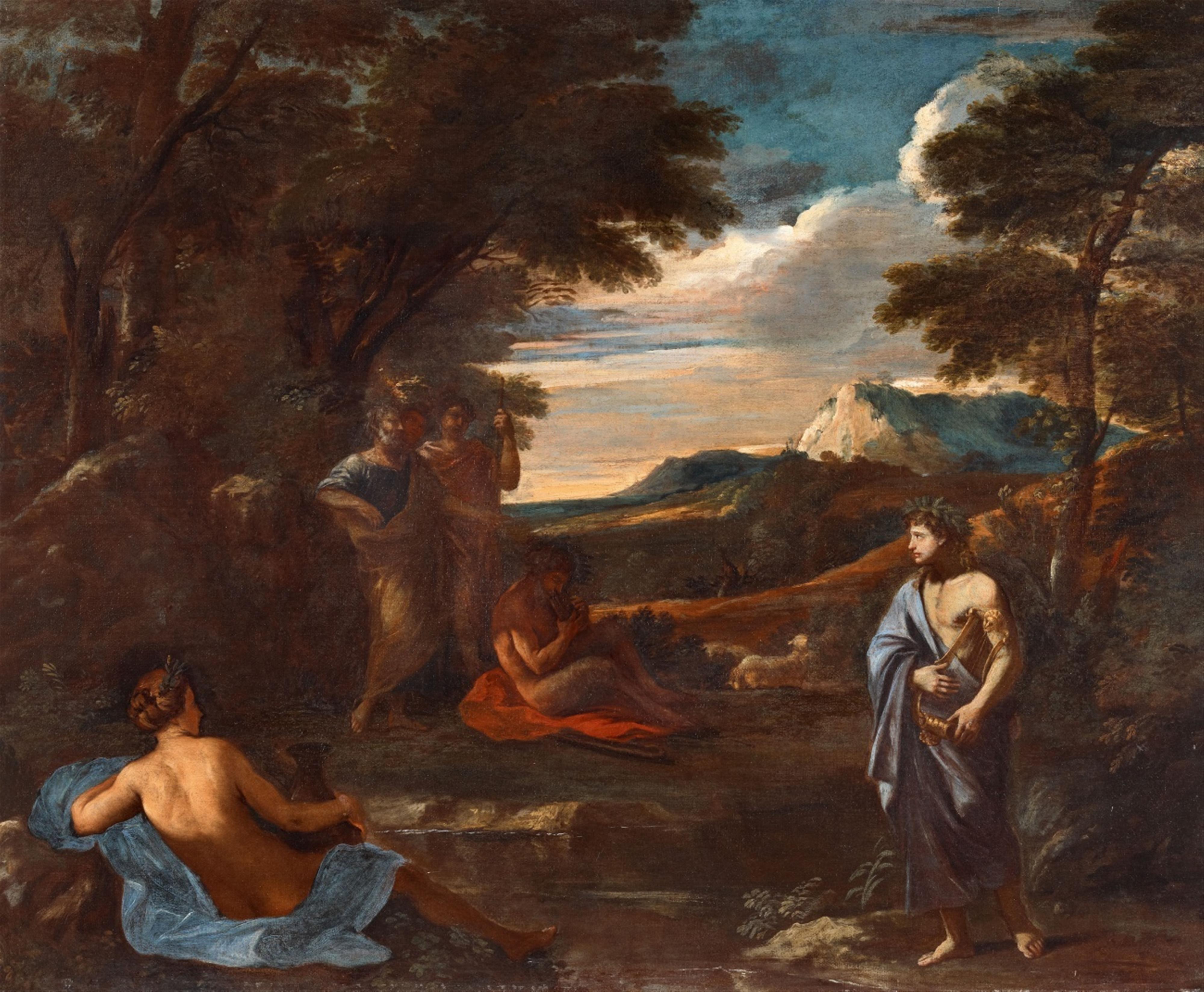Nicolas Poussin
Landscape with Apollo and Marsyas
Oil on canvas (relined). 73.5 x 90 cm.
The author Denis Mahon has convincingly illustrated this landscape with Apollo and Marsyas to be product of Nicolas Poussin's early years in Rome. Mahon dates the image to 1627 and considers it to be a fine example of Poussin's attempts to formulate a neoclassical style of landscape painting, using elements of classical and contemporary Italian art (Mahon, op. cit., passim).
We see a landscape of rolling hills bracketed on the right by a group of trees and a further tree on the left. A river flows through the foreground of the work, and snow-capped mountains span the horizon. Several figures populate the landscape: Apollo is shown on the right wearing a laurel wreath and playing his lyre. We see the satyr Marsyas crouching in the shadow of a grove in the mid-ground playing his pipes. Three men stand watching him in the shadows of the group of trees and a female figure lays recumbent in the left foreground. The story of Apollo's contest with Marsyas is found in Ovid's Metamorphosis (6:382-400), among other sources, and tells of how the God cheated to avoid a tie with the satyr. He augmented the competition to his advantage, telling Marsyas that to win he too had to play his instrument upside down and accompanied with vocals, feats impossible for the satyr to achieve with his double flute. Marsyas lost the competition and for this Apollo skinned him alive. Rather than depict this gruesome punishment like Titian or Ribera, Poussin has concentrated on the competition itself.
Denis Mahon, and Hugh Brigstocke before him, brought this landscape with Apollo and Marsyas into connection with another of Nicolas Poussin's landscapes, namely his “Numa Pompilius and the Nymph Egeria” kept in the Musée Condé in Chantilly (illustration; inv. no. PE 301) and which once belonged to Cassiano dal Pozzo. The positions of the landscape elements and figures in this work are identical to those of the work in Chantilly, with the tree on the right edge of the work and the group of figures behind Marsyas being the only additions. Mahon remarks: “Certainly the relationship of The Contest of Apollo and Marsyas to the Chantilly picture is of so intricate a nature, and the handling and execution of both paintings is so similar, as to preclude a different hand for The Contest of Apollo and Marsyas” (Mahon, op. cit., p. 26).
Poussin often reiterated his landscape compositions during his early years in Rome, such as in the case of “Nymph and Satyr Drinking” (National Gallery of Ireland, Dublin and Museo del Prado, Madrid) or “Nymph Surprised by Satyrs” (Kunsthaus Zurich, Zurich and National Gallery, London). In this work Mahon recognises an example of Poussin retaining the composition of a piece but changing the motif. One reason for this could be that the story of Marsyas and Apollo is a more well-known theme than the somewhat obscure tale of Numa Pompilius, presumably providing the work with a wider audience. With regard to the provenance of the piece, Mahon notes a work mentioned in the estate inventory of the Duke Carlos II of Mantua from 1665, which lists a work as follows “quadro picolo la contesa de Marsia e Apolo co un altra figura del Posino”.
The present work is among a series of classical landscapes which Poussin created whilst influenced by cinquecento artists like Titian, but also contemporaries such as Pietro da Cortona. This group includes his slightly earlier “Landscape with Arcadian Shepherds” (Walker Art Gallery, Liverpool), which anticipates the composition of the present work (of the development of Poussin's early landscapes and the place of the painting in the Musée Condé within this development, cf.: Konrad Oberhuber: Poussin - The Early Years in Rome. The Origins of French Classicism. New York 1988, p. 150).
Provenance
Swedish aristocratic ownership. - Carl Alden, London 1998. - Private collection Rome.

